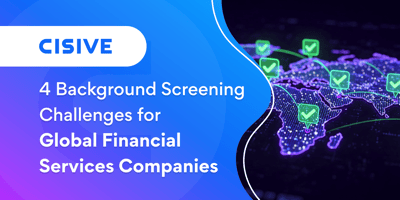%20-%20Blog%20Post.png)

The office of the Federal Deposit Insurance Corporation (FDIC) was created by the Banking Act of...
%20-%20Blog%20Post.png)
Financial services compliance monitoring has never been more critical for HR and risk management leaders. In an industry where trust is everything, failing to identify emerging risks within your workforce can lead to devastating financial, legal, and reputational consequences.
The reality is stark: insider threats are on the rise. Nearly half financial institutions reported an increase in insider threats over the past years, with 45% reporting more than five incidents in the last year, according to Trustwave’s 2024 Financial Services Deep Dive on Insider Threats.
The risk of bad actors jeopardizing your financial institution is only growing. Do you have a plan in place to mitigate these threats? To keep up with evolving threats and increasing regulatory demands, financial institutions need a proactive, real-time solution that can continuously monitor their workforce for potential risks.
Explore the benefits of ongoing background screening in financial services, and how to implement a financial services compliance monitoring program in your institution.

Financial institutions depend on background checks to make sure new hires are suitable for their roles. Traditionally, however, financial background checks are done before hiring and only capture a single point in time. While this step is important, it’s not enough. Employees may engage in criminal behavior, experience financial instability, or fail to maintain necessary licenses after the initial screening, creating unseen risks.
Organizations relying on traditional background checks are basing their trust on outdated information, leaving them blind to potential risks that can emerge over time. A one-time review at the hiring stage fails to account for changes such as new legal issues, financial challenges, or expired certifications. Without continuous monitoring, these risks go unnoticed, jeopardizing compliance and organizational trust. For companies sticking to static checks, regular manual reviews are a must to stay ahead of potential issues and ensure the reliability of their workforce.
New threats can arise long after the initial background check is completed. An employee might engage in illegal activities, such as fraud, theft, or other financial misconduct. Without ongoing monitoring, these issues remain unnoticed, leaving financial institutions exposed to operational and legal risks. A single unaddressed threat can compromise workplace safety, trust, and regulatory compliance.
Financial services organizations face strict oversight. Regulations like FDIC Section 19 and FINRA Rule 3110 require institutions to monitor employees consistently to avoid compliance failures. Failing to monitor compliance can lead to penalties, legal action, and disruptions to operations. To keep up with these compliance requirements, financial institutions need a system that tracks changes in real-time and flags issues quickly.

Compliance monitoring in financial services is an ongoing compliance process that checks employees’ backgrounds for risks long after they’re hired. It uses automated tools to provide real-time updates on any new issues, such as criminal activity, financial inconsistencies, or expired licenses. Unlike traditional checks, which only offer a single snapshot, continuous monitoring gives financial institutions a complete, up-to-date view of their workforce.
Continuous criminal monitoring tracks employee arrests and convictions as they happen. Instead of waiting for periodic rechecks, this system alerts compliance teams in near real-time, allowing them to take swift corrective action. For example, if an employee is arrested for fraud, an immediate alert lets the company investigate and address the issue before it becomes a larger problem.
Financial professionals, such as brokers and loan officers, must maintain active licenses to comply with industry standards. Continuous monitoring helps financial institutions identify potential risks by flagging expired, revoked, or lapsed credentials. This proactive approach ensures that organizations meet regulatory requirements and avoid compliance issues.
Using tools like Cisive’s Financial Anomalies Search Technology (FAST), financial institutions can cross-check employee disclosures against public records. This process helps identify any mismatches or financial irregularities, ensuring transparency and reducing the risk of misconduct. For instance, a discrepancy in self-reported financial history could signal a larger risk that requires immediate investigation.
Continuous monitoring aligns with key regulatory requirements, such as the SAFE Act and FDIC background check requirements. By providing real-time updates on employee compliance, financial institutions can remain audit-ready and ensure they are meeting all industry standards. This level of oversight simplifies compliance audits and reduces the chance of penalties.

Continuous compliance monitoring offers financial institutions a proactive approach to managing risks and meeting regulatory demands. By providing real-time visibility into your workforce, it ensures you stay ahead of potential threats while protecting your organization’s reputation. Here are the key benefits of implementing an effective compliance monitoring program.
Continuous monitoring helps financial institutions identify areas of risk early, giving them time to act before problems escalate. By flagging criminal behavior, financial anomalies, or license expirations in real time, companies can take corrective action quickly.
Meeting regulatory requirements like compliance with FINRA Rule 3110, FDIC Section 19, and the SAFE Act is critical in financial services. Continuous monitoring helps institutions monitor compliance seamlessly by keeping employee records up to date and ensuring all licenses and credentials are valid. This approach simplifies compliance audits and minimizes the risk of costly penalties.
An organization’s reputation is everything in financial services. News of employee misconduct or compliance failures can damage client trust and have long-term consequences. By using an effective compliance monitoring program, financial institutions can quickly address flagged issues. This proactive approach ensures integrity and helps maintain confidence among clients and stakeholders.
Manual background checks are time-consuming, expensive, and prone to errors. An effective compliance monitoring system automates these tasks, freeing up compliance teams to focus on higher-level risk management strategies. By automating monitoring processes, institutions can work more efficiently while staying ahead of potential compliance risks.

Implementing an effective compliance monitoring program involves clear policies, automated tools, and strategic execution. Here are the steps to getting started in your financial institution.
Start by defining what you want to monitor — criminal activity, financial disclosures, or license expirations. Create protocols for addressing any flagged results. By establishing clear policies, your institution ensures alignment with regulatory requirements and industry best practices.
To comply with the Fair Credit Reporting Act (FCRA) and similar laws, financial institutions must obtain written consent from employees for continuous monitoring. Be transparent about the purpose of monitoring and how it benefits the workplace. Open communication builds trust and reduces resistance.
Partnering with a trusted provider like Cisive ensures seamless automation of your compliance monitoring system. Automation delivers real-time alerts to compliance teams when issues arise, enabling immediate corrective action. This reduces manual effort and increases accuracy.
When the system flags potential risks, compliance teams must verify the findings and take appropriate action. For example, an alert about a new criminal conviction may require a deeper investigation, HR involvement, or legal consultation.
Educate employees on how continuous monitoring protects the workplace, reduces risk, and ensures compliance. By explaining the benefits, institutions can foster a culture of trust, safety, and accountability.
The regulatory landscape for financial institutions is constantly evolving, requiring organizations to stay ahead of changes to avoid compliance risks. Innovations in technology, such as artificial intelligence, machine learning, and digitized records, will further improve compliance monitoring systems. These advancements will enhance risk assessment, reduce human error, and provide faster, more reliable results.
Financial institutions that invest in advanced monitoring tools today will be better equipped to adapt to new compliance requirements and maintain a competitive edge. By staying proactive, organizations can protect their reputations, meet industry standards, and simplify risk management processes.
Ready to enhance your compliance management program? Learn how Cisive can transform your financial services compliance efforts. Schedule a consultation today.
Author: Vaun Longhorn
Bio: Background screening expert with expertise in financial services at Cisive.
Let's Connect on LinkedIn
The office of the Federal Deposit Insurance Corporation (FDIC) was created by the Banking Act of...

Background screening in global financial services isn’t just about verifying credentials—it’s about...

Vendor relationships are the backbone of modern financial services operations, handling such areas...